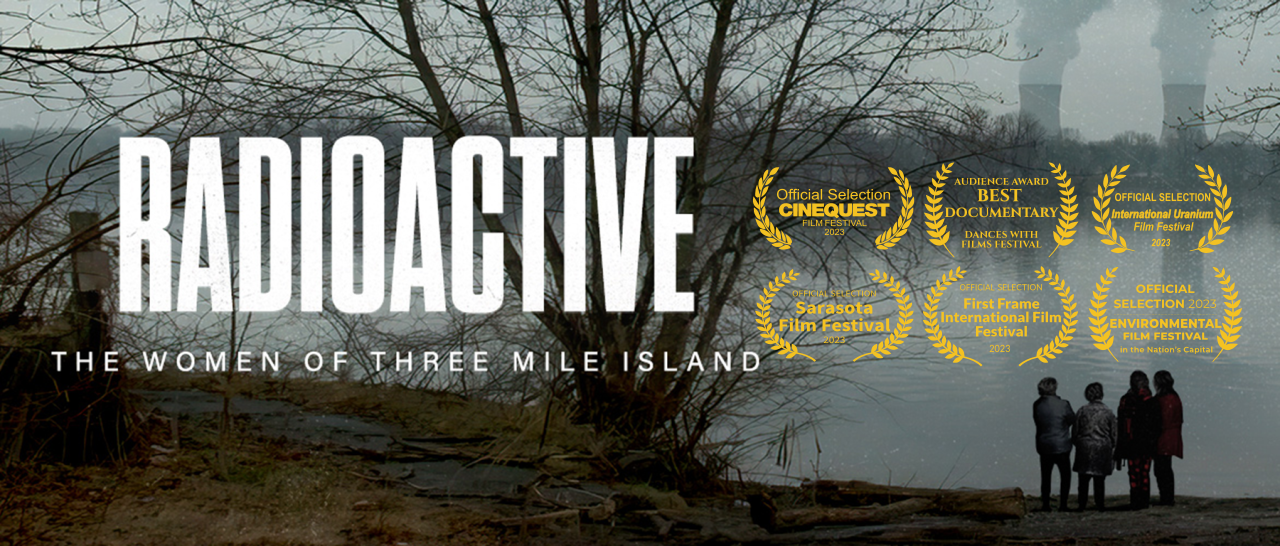By Karl Grossman

radioactivethefilm.com
“Radioactive: The Women of Three Mile Island,” is the title of a newly-released documentary feature film directed, written and produced by award-winning filmmaker Heidi Hutner, a professor of environmental humanities at Stony Brook University.
With greatly compelling facts and interviews, she and her also highly talented production team have put together a masterpiece of a documentary film.
It connects the proverbial dots of the 1979 Three Mile Island nuclear plant disaster and does so brilliantly.
The documentary has already received many film awards and has had screenings in recent months in Manhattan, winning the Audience Award for Best Documentary at the Dances with Films Festival. It has also won First Frame International Film Festival in Manhattan and the Environmental Film Festival in Washington D.C. It will soon be the featured film at Kat Kramer’s #SHEROESForChange Film Festival in Los Angeles, the Cinequest Film Festival in San Jose, California, as well as the Uranium Film Festival in Rio de Janeiro in Brazil.
It will be shown at the Staller Center Stony Brook Film Festival on the campus of Stony Brook University on Friday, July 26, at 7 p.m.
Residents of the area around Three Mile Island are interviewed and tell heartbreaking accounts of the widespread cancer that ensued in the years that have followed the accident – a cancer rate much higher than normal.
A whistleblower who had worked at the nuclear plant tells Hutner of the deliberate and comprehensive attempt by General Public Utilities, which owned TMI, to cover up the gravity of the accident and its radioactive releases, especially of cancer-causing Iodine-131 and Xenon 133.
Attorney Lynne Bernabei, involved in litigation in the wake of the accident, says the
Three Mile Island “cover-up was one of the biggest cover-ups in history.”
Meanwhile, the U.S. Nuclear Regulatory Commission, which is supposed to protect the
public, has then and since been just “interested in promoting the [nuclear] industry. This
is corrupt,” according to attorney Joanne Doroshow, now a professor at New York Law School and director of the Center for Justice & Democracy.
The documentary’s focus on the women it includes is supported by the fact that women are far more at risk to the effects of radioactivity than men. Mary Olson, a biologist and founder and director of the Gender & Radiation Impact Project, says in the film that those setting radiation standards in the U.S. from the onset of nuclear technology in 1942, based impacts on a “25- to 30 year-old males defined as Caucasian.” She said, “It has come to be known as the Reference Man.” However, Olson cites research findings that “radiation is 10 times more harmful to young females” and “50% more harmful to a “comparable female” than it is to Reference Man who is “more resistant” to radioactivity than a woman.
After the screening of the documentary at the Cinema Arts Centre in Huntington, the showing I attended in April, there was a panel discussion involving Hutner, four women featured in the documentary, and its editor Simeon Hutner, who is also a producer.
The discussion was moderated by Kelly McMasters, author of the memoir, “Welcome to Shirley, A Memoir of an Atomic Town,” and a professor at Hofstra University. McMasters in her book attributes wide-ranging cancer in her hometown of Shirley, a hamlet just north of the eastern end of Fire Island, to radioactive releases from three nuclear reactors that operated at the adjacent Brookhaven National Laboratory, reactors that are now shut down.
Of her documentary, Hutner, a Huntington resident, says: “With nuclear power being discussed in some circles as an ‘answer’ to our climate crisis, we believe anyone seeing this film will walk away with the unmistakable conclusion that nuclear power must be off the table.”
The documentary’s website is: https://radioactivethefilm.com/




























